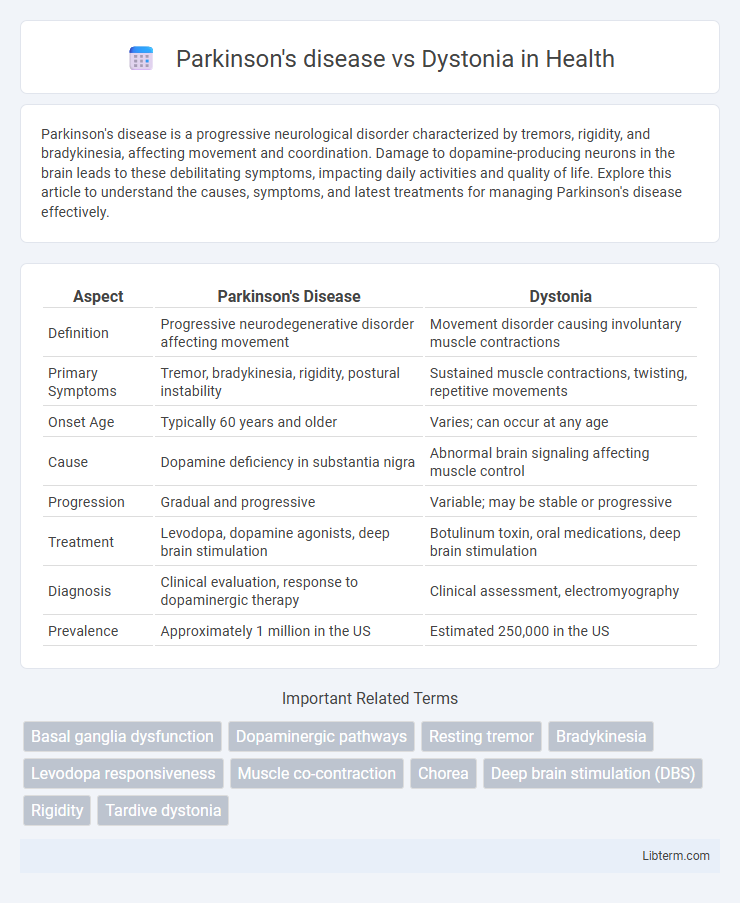Parkinson's disease is a progressive neurological disorder characterized by tremors, rigidity, and bradykinesia, affecting movement and coordination. Damage to dopamine-producing neurons in the brain leads to these debilitating symptoms, impacting daily activities and quality of life. Explore this article to understand the causes, symptoms, and latest treatments for managing Parkinson's disease effectively.
Table of Comparison
| Aspect | Parkinson's Disease | Dystonia |
|---|---|---|
| Definition | Progressive neurodegenerative disorder affecting movement | Movement disorder causing involuntary muscle contractions |
| Primary Symptoms | Tremor, bradykinesia, rigidity, postural instability | Sustained muscle contractions, twisting, repetitive movements |
| Onset Age | Typically 60 years and older | Varies; can occur at any age |
| Cause | Dopamine deficiency in substantia nigra | Abnormal brain signaling affecting muscle control |
| Progression | Gradual and progressive | Variable; may be stable or progressive |
| Treatment | Levodopa, dopamine agonists, deep brain stimulation | Botulinum toxin, oral medications, deep brain stimulation |
| Diagnosis | Clinical evaluation, response to dopaminergic therapy | Clinical assessment, electromyography |
| Prevalence | Approximately 1 million in the US | Estimated 250,000 in the US |
Understanding Parkinson's Disease: Key Features
Parkinson's disease is a neurodegenerative disorder characterized by the progressive loss of dopamine-producing neurons in the substantia nigra, leading to motor symptoms such as tremor, bradykinesia, rigidity, and postural instability. Unlike dystonia, which primarily manifests as involuntary muscle contractions causing repetitive movements or abnormal postures, Parkinson's disease also involves non-motor symptoms including cognitive decline, autonomic dysfunction, and mood disorders. Understanding the distinct pathophysiology and symptomatology of Parkinson's disease is critical for accurate diagnosis and tailored treatment strategies.
What is Dystonia? Defining the Disorder
Dystonia is a neurological movement disorder characterized by involuntary muscle contractions causing repetitive movements or abnormal postures. Unlike Parkinson's disease, which primarily involves tremors and bradykinesia due to dopamine deficiency, dystonia results from dysfunction in the basal ganglia leading to sustained or intermittent muscle contractions. This disorder can affect various body parts, presenting as focal, segmental, or generalized dystonia, and significantly impacts motor control and quality of life.
Causes and Risk Factors: Parkinson’s Disease vs. Dystonia
Parkinson's disease primarily results from the degeneration of dopamine-producing neurons in the substantia nigra, with risk factors including age, genetics, and environmental exposures such as pesticides. Dystonia is caused by abnormal functioning or damage in the basal ganglia or nervous system, often linked to genetic mutations, brain injury, or exposure to certain medications. While Parkinson's involves progressive neurodegeneration affecting movement and coordination, dystonia is characterized by involuntary muscle contractions leading to abnormal postures or repetitive movements.
Core Symptoms: How Parkinson’s and Dystonia Differ
Parkinson's disease primarily manifests through bradykinesia, resting tremor, rigidity, and postural instability, reflecting dopaminergic neuron loss in the substantia nigra. In contrast, dystonia is characterized by sustained or intermittent muscle contractions causing abnormal, often repetitive, movements or postures, linked to dysfunction in the basal ganglia and sensorimotor integration. These core symptom differences highlight Parkinson's motor slowing and tremor versus dystonia's involuntary muscle contractions and abnormal postures.
Diagnostic Challenges: Distinguishing Between Both Conditions
Diagnosing Parkinson's disease versus dystonia presents significant challenges due to overlapping motor symptoms such as tremors, rigidity, and abnormal postures. Parkinson's disease is primarily characterized by bradykinesia and resting tremor, whereas dystonia involves sustained muscle contractions causing twisting and repetitive movements or abnormal postures. Advanced neuroimaging, detailed clinical assessment, and response to dopaminergic therapy are crucial for accurate differentiation between these movement disorders.
Treatment Options for Parkinson’s Disease
Parkinson's disease treatment primarily involves dopamine replacement therapy using levodopa or dopamine agonists to manage motor symptoms. Deep brain stimulation (DBS) offers an effective surgical option for patients with medication-resistant symptoms, targeting areas like the subthalamic nucleus. Physical therapy and medications such as MAO-B inhibitors also play essential roles in improving quality of life and symptom control.
Treatment Approaches for Dystonia
Dystonia treatment primarily involves botulinum toxin injections, which target muscle spasms and improve motor control by blocking abnormal nerve signals. Oral medications like anticholinergics, muscle relaxants, and dopamine agonists may also help reduce symptoms. Deep brain stimulation (DBS) is an effective surgical option for severe dystonia when medications and botulinum toxin fail to provide sufficient relief.
Prognosis and Disease Progression Comparison
Parkinson's disease typically demonstrates a progressive loss of motor function characterized by tremors, rigidity, and bradykinesia, with prognosis varying based on age of onset and response to dopaminergic therapy. Dystonia presents with sustained or intermittent muscle contractions causing abnormal postures, often exhibiting a more variable progression and sometimes stabilizing or improving with treatment. Prognostically, Parkinson's involves a continuous decline affecting quality of life, whereas dystonia's progression is less predictable and may remain focal or spread depending on etiology and therapeutic interventions.
Living with Parkinson’s Disease vs. Dystonia: Daily Impacts
Living with Parkinson's disease involves managing symptoms such as tremors, rigidity, and bradykinesia, which significantly affect mobility and fine motor skills, making daily activities like dressing and eating challenging. In contrast, dystonia is characterized by sustained or intermittent muscle contractions causing abnormal postures or repetitive movements, often leading to pain and functional impairment in specific body regions. Both conditions require tailored therapeutic approaches to improve quality of life, including medication, physical therapy, and sometimes surgical interventions, but the daily impacts differ due to the distinct nature of motor symptoms and progression.
Recent Advances in Research and Future Directions
Recent advances in Parkinson's disease research emphasize novel biomarkers and gene therapies targeting alpha-synuclein aggregation to slow neurodegeneration. Dystonia studies highlight neuroplasticity modulation through deep brain stimulation and non-invasive brain stimulation techniques enhancing symptomatic relief. Future directions include personalized medicine approaches, integrating genomic data and advanced neuroimaging to optimize therapeutic interventions for both movement disorders.
Parkinson's disease Infographic

 libterm.com
libterm.com